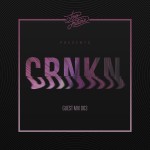We’ve teamed up with Point Blank Studios to bring you a brand new series that dives into the world of electronic dance music production. In partnership with Point Blank Music School, this production series will be recurring with a variety of installments that will include guest posts from hot up and coming artists who will offer inside tips, detailed looks into the minds and tools of producers, as well as tricks of the trade for all you aspiring producers at home.
You’ll get to hear from your many different artists and get an inside look at how they look at and work in the studio. Even if you’re not a producer, our new series is a cool glimpse inside the mindsets of some of your favorite artists.
For the fourth edition of our series we have CRNKN dishing out some helpful tips on how to mix your drums properly.
1. Sample Choice
For me, the most important part of mixing drums is sample choice. If you pick your samples carefully, odds are when it comes time to mix, they’ll fit together more cohesively. Try to pick samples that won’t take up too much room in the mix, that way you won’t have to cycle through more than once to find the right sample. I personally mix my whole song around the drums, so this part is super super important.
2. Compress, Compress.
This is the best way to make your drums more known and more present. A common question for beginning producers is how to make their tracks sound louder, and well, it starts with drum compression. Using a compressor or multi-band compressor that’s compressing only a few DB’s with a medium / short attack is a great place to start for kicks / snares etc. Parallel compression (or New York compression) is also really useful if you feel some of your drums are lacking in punch / force. Basically you do this by layering a dry version of your sample and a heavily processed (slight reverb, and compression) one together.
3. EQing is your friend
Another thing that’s super crucial for making sure all of your drums sit in conjunction with one another is making sure you EQ. Dipping out the mids when possible, slightly boosting the lows for power, and the highs for poignance are a couple ways to give your drums a little more life while also cleaning them up. Make sure you use your EQ in tandem with a spectrum analyzer so you can see exactly which frequencies need to be shaved off and which could use to be boosted!
4. Don’t stereo image too much
In case you don’t know what stereo imaging is, it’s basically when you widen the signal of any given sample or sound so that it sounds like it’s surrounding you, rather than sitting right in front. Listening through soundcloud and promos I’ve received lately, I’ve noticed that a lot of producers seem to think the wider, the better. While it’s true that stereo imaging can really make certain sounds very interesting (chords, vocals, small percussion), it can also ruin the dynamics of other sounds. I would just say to try to not widen more than a few things in your mix for fear of it sounding unbalanced!
5. Importance of drum mixing is often overlooked
It’s easy to feel a little less interested in mixing drums because they’re not necessarily the first thing you notice in a track. The drums set the tone for your whole track and a sample can be pushed and manipulated in a million different directions so have fun with it! They’re the backbone of any flushed out track, so make sure you put those stakes in the ground early!
6. Bonus tip: Less is often more
Not everyone will agree with me on this one, but I’ve found that my best mixes have come from drum structures that are simple, but interesting, and allow lots of leftover room. By this I mean to not have 75000 different loops working against each other, rather have 5 or 6 tracks of drum samples to move the track along. This helps mitigate auditory and visual clutter
For more expert tips, visit Point Blank, the award-winning music production and DJ school with classes in London, Los Angeles and online. Six-time ranked ‘Best DJ & Production School’ by DJ Mag, Point Blank offers ground-breaking courses taught by expert instructors including songwriters, producers and Grammy award winners. Former students include: Claude VonStroke, Nicole Moudaber, Gareth Wyn, AlunaGeorge and more. Head to their site for production tips, tutorials or to sample an online course for free.
CRNKN
Facebook | SoundCloud | Twitter | Instagram
▲ ▲ Read More About CRNKN Here ▲ ▲
STAY IN THE KNOW! FOLLOW US ON SPOTIFY









Leave a Reply
You must be logged in to post a comment.